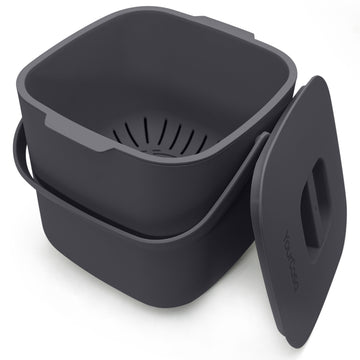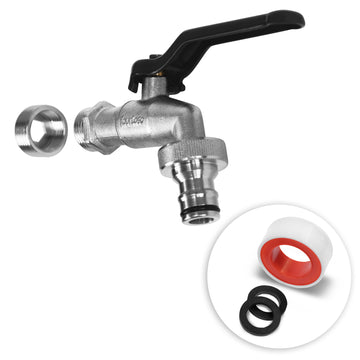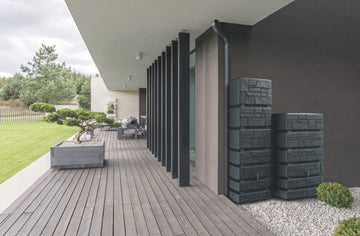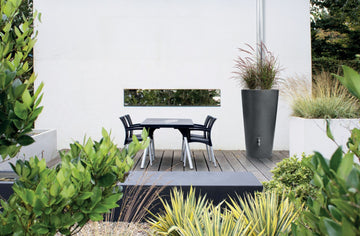The right rain barrel pump – what you should pay attention to when buying
by Robert Zielinski on Aug 05, 2024

You might not believe us straight away - but a rain barrel pump is indispensable for every garden owner. Once you have one, you will never want to be without it. With a rain barrel pump, you can use your collected rainwater directly for watering or to operate a sprinkler .
The option to schedule watering is particularly practical. In combination with a watering computer, you can set the pump so that it distributes the water in the evening, for example. Put an end to stressful watering before work or after work when you really just want to relax on the sofa.
And that's not all: timed watering also makes ecological sense , as less water evaporates and your plants are optimally supplied. In addition, using rainwater saves precious tap water and protects the environment. A high-quality pump makes gardening easier for you and ensures that your garden stays healthy and green.
What are the benefits of a rain barrel pump? A rain barrel pump allows you to use your collected rainwater more efficiently. You can use it to water directly from the barrel or operate a sprinkler. This saves you tap water and costs. It allows you to carry out irrigation on a timed and automated basis. This makes garden maintenance easier in general and ensures an optimal water supply. Using rainwater is also environmentally friendly, as less drinking water is wasted.
In this article, you will learn what types of rain barrel pumps there are, what advantages and disadvantages they offer and how to use them correctly.
What types of rain barrel pumps are there?
If you have never dealt with the topic before, you may feel a little overwhelmed. Submersible pumps, domestic waterworks, battery-operated pumps ... there are several types of rain barrel pumps that offer very different advantages and disadvantages. We will introduce you to the most common types and shed some light on the subject.
Submersible pumps
Submersible pumps are installed directly in the rain barrel and pump the water from bottom to top . These pumps are particularly efficient, quiet in operation and take up little space. They are ideal for watering gardens, filling watering cans or operating sprinkler systems. Another advantage is their ability to work reliably even when the water level is low.
|
category |
Model |
|
Professional quality |
Gardena Comfort submersible pump 4000/2 |
|
Price-performance winner |
Einhell GE-SP 750 LL |
|
Low-Budget |
TIP 30111 ELP3 |
Suction pumps
Suction pumps are placed outside the rain barrel and suck the water in through a hose . They are particularly powerful and versatile, for example for larger gardens or for supplying several extraction points at the same time. Another advantage of suction pumps is that they are easy to access for maintenance work. Despite their robustness and durability, they are unfortunately often louder in operation.
|
category |
Model |
|
Professional quality |
Metabo P 4000 G |
|
Price-performance winner |
Gardena 3000/4 |
|
Low-Budget |
Einhell GC-GP 6538 |
Domestic waterworks
Domestic waterworks are complex systems that automatically distribute the collected rainwater throughout the house . They are ideal for operating washing machines, toilets or for watering the garden. These pumps offer a constant water pressure and are particularly powerful. Domestic waterworks are useful if you want to ensure a permanent and extensive water supply with rainwater and are ideal for households that want to use rainwater systematically and on a larger scale.
|
category |
Model |
|
Professional quality |
Gardena 5000/5 Stainless Steel |
|
Price-performance winner |
Einhell GE-WW 5537 E |
|
Low-Budget |
TIP HWW 1300/25 Plus |
Battery pumps
Battery pumps offer maximum flexibility as they can be operated independently of a power source. They are available as both submersible and suction pumps and are particularly suitable for mobile use or for gardens without a power connection. Battery pumps are ideal for smaller gardens or temporary watering tasks. The battery operation makes them particularly user-friendly and easy to handle - but they are not as powerful as other variants.
|
category |
Model |
|
Professional quality |
Kärcher BP 2 Garden Set |
|
Price-performance winner |
Einhell GE-PP 18 RB Li |
|
Low-Budget |
Gardena 2000/2 Li-18 |

Criteria for choosing the right rain barrel pump
So now you know which common rain barrel pumps there are. The next question is: which one is right for you? There is no short answer to that. Instead, you should be clear from the outset about what you want to use your pump for. We will show you which factors you should take into consideration .
Performance and flow rate
The performance and flow rate of a pump determine how effectively the water is pumped out of the rain barrel. The required pumping power is calculated from the height that the water has to overcome and the diameter of the hose used .
Generally speaking, the larger the barrel and the higher the discharge head, the more power the pump needs . The hose diameter also affects the discharge rate; a wider hose reduces pressure loss and allows for a higher flow rate. Here is a typical pump performance chart showing how the discharge rate varies at different heights.
Size and volume of the rain barrel
The size and volume of your rain barrel also play a significant role in choosing the right pump. For small rain barrels up to 200 liters, a compact and slightly less powerful pump is suitable. Medium-sized barrels between 200 and 500 liters require a pump with medium power. Large rain barrels over 500 liters require powerful pumps that can efficiently pump large amounts of water. Here are some suitable rain barrels from YourCasa:
|
Model |
volume |
Price (in €) |
|
Small (up to 200 L) |
79.99 |
|
|
Medium ( 200–500 L) |
109.99 |
|
|
Large (over 500 L) |
384.99 |
Energy efficiency and operating costs
The energy efficiency of a pump has a direct impact on operating costs and environmental friendliness. Energy-saving pumps use less electricity and therefore reduce your running costs. When making your selection, you should pay attention to the power consumption in watts .
An example: A 500 watt pump that runs for one hour a day consumes around 15 kWh per month. At an electricity price of €0.30 per kWh, this results in monthly costs of €4.50.
Particularly efficient models often work with 300-400 watts without compromising on performance. However, the actual energy consumption also depends on the duration and frequency of use. A 300-watt pump that runs for an hour a day consumes around 9 kWh per month. At an electricity price of €0.30 per kWh, this results in monthly costs of €2.70.
In the long term, it is worth investing in an energy-efficient pump in order to minimize operating costs and protect the environment.
Durability and quality
If you want to use your pump frequently , for example because you live in a rainy area or have a large garden, you should make sure that the pump is of high quality and durable. A long guarantee period is often an indicator of the manufacturer's reliability - because high-quality pumps are made of robust materials and have low-wear components. The leading manufacturers include Gardena, Einhell and Metabo. Here are the guarantee periods of the most important manufacturers:
|
Manufacturer |
Warranty period |
|
Gardena |
5 years |
|
e-shopping |
3 years |
|
Metabo |
3 years |
Installation and commissioning of a rain barrel pump
Installing and commissioning your new rain barrel pump can be done in just a few steps - and it's really child's play. First, you should assemble the pump according to the manufacturer's instructions and prepare all the necessary connections.
With submersible pumps, it is important to place the pump securely in the rain barrel and ensure that it is stable. Suction pumps require a fixed location outside the barrel and a suitable suction hose that reaches to the bottom of the barrel. Make sure that the power supply is rainproof and that the power cable does not pose a tripping hazard.
Of course, things are different with domestic waterworks – in this case, you usually need professional help to install the pipes and pumps.
Here is a checklist for commissioning your rain pump:
-
Assemble pump according to manufacturer’s instructions
-
Place submersible pump safely in the rain barrel
-
Connect suction hose for suction pumps correctly
-
Ensure stable and rainproof power supply
-
Lay the power cable safely and protect it from moisture
-
Fill pump with water if necessary
-
Perform functional test
-
Program automatic watering settings, if available
Maintenance and care – so you can enjoy your rain barrel pump for a long time
To ensure that your pump does its job for as long as possible and does not give up the ghost after a short time, regular maintenance and care is crucial .
One of the most important measures is to regularly inspect the pump for wear and damage . In particular, check the seals and the suction hose occasionally for cracks or leaks. A thorough cleaning of the pump should ideally be done about once a month. This removes deposits and dirt that could affect performance. Rinse the pump thoroughly with clean water and remove any blockages in the filter or hoses.
Preparing the pump for winter is particularly important. To avoid frost damage, you should remove the pump from the rain barrel before the first frost. Allow the remaining water to drain completely and clean the pump thoroughly before storing it in a frost-free place. Also check all hoses and connections and make your rain barrel winter-proof .

Useful accessories for your rain barrel pump
In order to exploit the full potential of your rain barrel pump and make watering your garden even more efficient, it is worth investing in useful accessories. Filters are particularly essential as they prevent dirt and deposits from getting into the pump and impairing its performance. Filters therefore ensure that the water stays clean and the pump lasts longer.
Timers are also extremely useful . They allow you to control garden watering automatically. Set when and for how long the pump will pump the water from your barrel into the garden. This is particularly useful if you want to water regularly at certain times, for example in the early morning or in the evening when evaporation is lower.
A small watering system can also be created by combining hose connections and distributors . These allow you to water several areas of your garden at the same time. By using drip hoses or sprinklers, you can make the water distribution even more targeted and efficient. By the way: On our blog you will find other helpful tips for your garden, for example how you can build a rainwater collection system yourself .
You can see an overview of particularly useful accessories in the following table:
|
Accesories |
function |
|
filter |
Prevents dirt and deposits from entering the pump |
|
Timer |
Automates watering, set times and duration |
|
Hose connections |
Allows you to connect multiple hoses and create an irrigation system |
|
Distributor |
Allows watering of several garden areas at the same time |
|
Drip hoses |
Ensures targeted and economical water distribution to the plants |
|
sprinkler |
Uniform irrigation of large areas |
Conclusion: The right rain barrel pump for your needs
So, which type of rain barrel pump you choose depends entirely on your personal needs. Think carefully about whether it is worth investing in a domestic waterworks or whether a normal submersible or suction pump would do the job.
But one thing is certain: investing in a rain barrel pump is always worth it. With a pump, you can supply your garden with water much more easily and evenly.
When buying, pay attention to the performance, flow rate, hose diameter and power consumption and buy your pump and accessories from specialised suppliers who offer high-quality products and comprehensive advice. This way you can ensure a long-lasting and efficient solution for your garden - and are guaranteed to buy one of the best rain barrel pumps.

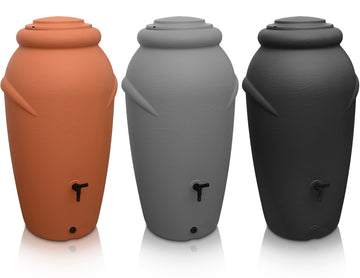
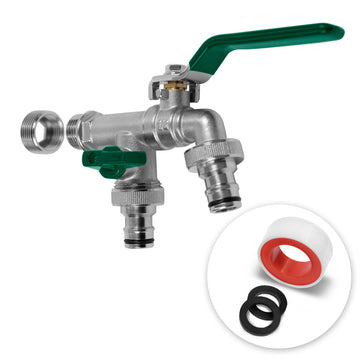
![Drei hohe YourCasa Regentonne 240 Liter [Wellen-Design] - Frostsicher & UV-beständige Gartentöpfe in den Farben Schwarz, Grau und Terrakotta, jeweils mit Drainagesystem für nachhaltige Bewässerung.](http://yourcasa.de/cdn/shop/files/ohnelogo_b8aeecac-557e-4106-a999-e77dcd160209.jpg?v=1707130230&width=360)
